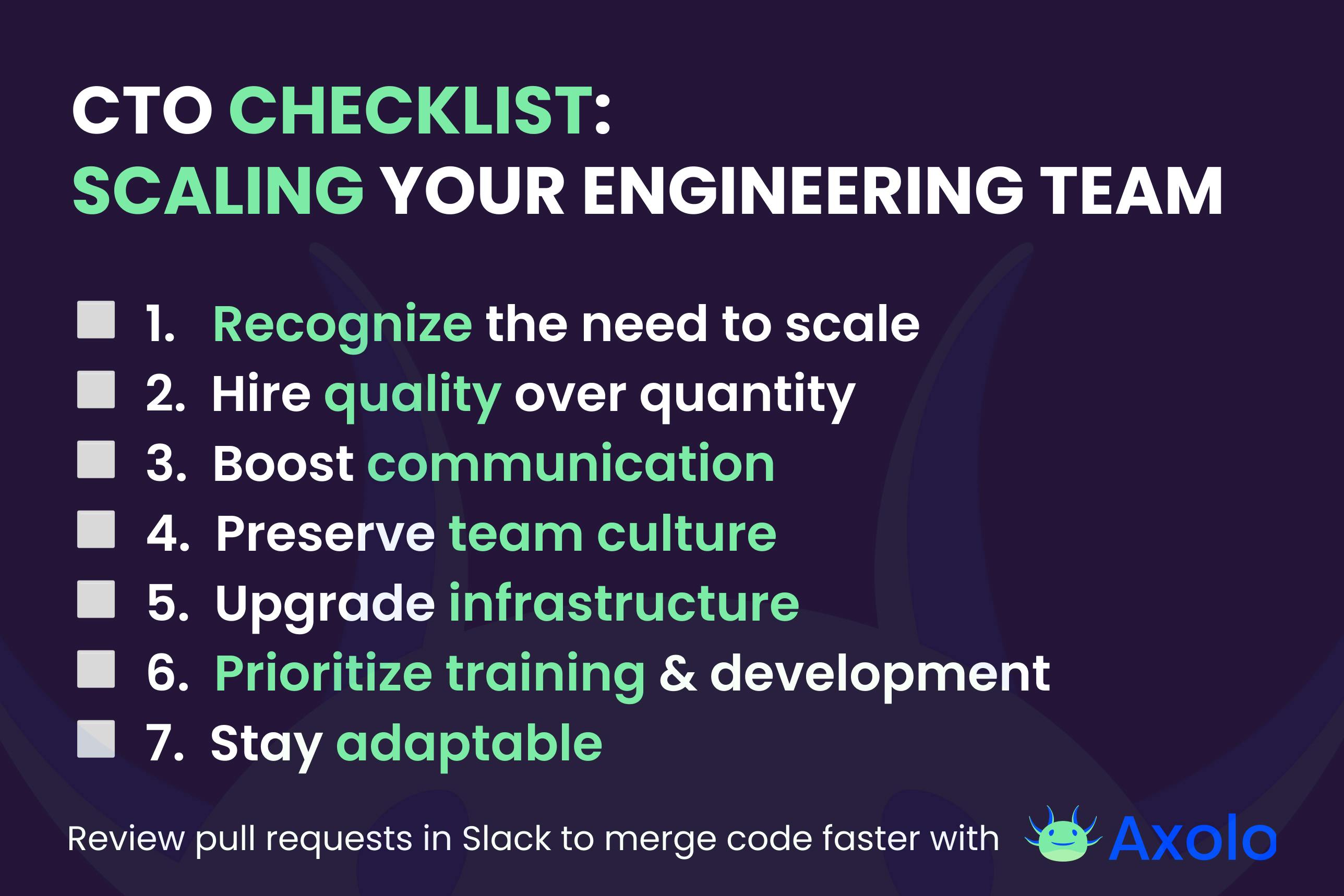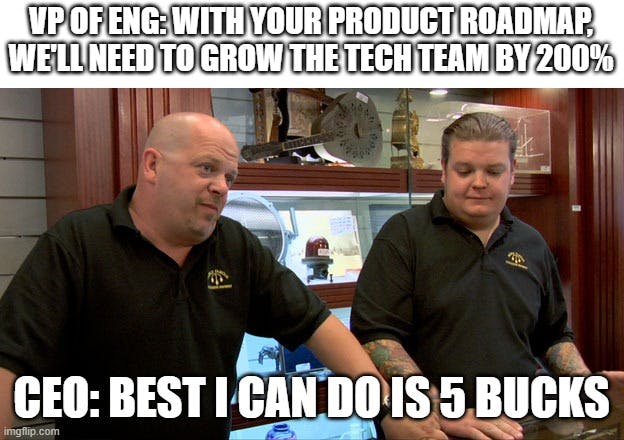- Published on Tuesday, September 26, 2023, last updated
CTO checklist: scaling your engineering team
Are you If yes, stay with us, if no, you can still stay with us but I don't know why you would.
In the dynamic world of tech, growth is inevitable, if you're good, or sometimes lucky. But as your projects expand and demands surge, how do you ensure that your engineering team scales effectively? Scaling isn't just about adding numbers; it's about ensuring each new member amplifies the team's productivity, communication remains streamlined, and the cherished team culture remains intact. In this guide, we'll explore the art and science of scaling an engineering team without missing a beat.

TL;DR: Scaling Your Engineering Team - Priority Checklist
- Recognize the Need to Scale: Monitor project backlogs, team burnout, and deliverable delays.
- Hire Quality Over Quantity: Focus on cultural fit, diverse skills, and essential soft skills.
- Boost Communication: Invest in effective tools and set clear communication protocols.
- Preserve Team Culture: Implement a robust onboarding process and regular team-building activities.
- Upgrade Infrastructure: Ensure a scalable tech stack and embrace automation.
- Prioritize Training & Development: Schedule continuous training, workshops, and establish mentorship programs.
- Stay Adaptable: As the team grows, be ready to evolve processes and tools to fit new needs.
Remember: Scaling is not just about growing in numbers, but in strength, cohesion, and innovation. If these 8 lines were enought for you to scale up to hundreds of engineers, good for you! If not, stay with me.
Table of Contents
1. Understanding the Need for Scaling
In the lifecycle of an engineering team, there comes a pivotal moment—a tipping point, if you will. It's the moment when the current team size and structure start to feel, well, a bit snug. But how do you recognize this moment? And more importantly, how do you navigate the challenges it presents? Let's delve deeper.
Signs It's Time to Scale:
- Overflowing Project Backlogs:
When tasks start piling up faster than they're being addressed, it's a clear sign that the team might be understaffed. An ever-growing backlog can lead to demotivation as it feels like the finish line keeps moving further away.
- Increased Burnout and Overtime:
If your team is consistently working late hours and feeling the strain, it's not just a productivity issue—it's a well-being issue. Burnout can lead to higher turnover rates and decreased quality of work.
- Delayed Deliverables:
Missing one deadline might be an anomaly, but if it becomes a pattern, it's time to reassess. Consistent delays can affect client relationships and the company's reputation.
- Decreased Code Quality:
When engineers are rushed or overwhelmed, code quality can take a hit. This can lead to more bugs, technical debt, and longer maintenance times in the future.
If you're interested in learning more about this subject, I wrote an article about .

It might be just the right time to scale.
The Risks of Waiting Too Long:
Hesitating to scale can lead to missed opportunities, strained client relationships, and a demoralized team. It's essential to be proactive rather than reactive.
The Pitfalls of Scaling Too Soon:
On the other hand, scaling prematurely can lead to its own set of challenges. Unused resources, increased overhead costs, and the potential for team members to feel underutilized are just a few of the potential pitfalls.
In conclusion, understanding when to scale requires a keen sense of observation, open communication with the team, and a dash of foresight. It's about balancing the immediate needs with future goals and ensuring that growth is strategic, sustainable, and beneficial for all involved.
Axolo is a Slack app to help techteams review pull request seamlessly
2. Hiring the Right Talent
Throwing a bunch of engineers at a problem might seem like a quick fix, but it's not always the most effective solution. The real magic happens when you bring on board individuals who not only have the technical chops but also align with the broader vision and culture of the company. Let's explore this in more detail.
The Essence of Quality Over Quantity
While it might be tempting to rapidly expand the team to meet growing demands, it's crucial to prioritize the quality of hires over sheer numbers. A well-rounded engineer who complements the team can contribute more than several hires who don't quite fit the bill.
Cultural Fit and Company Values
Every company has its unique values, and ways of working. When scaling, it's essential to find engineers who resonate with these aspects. A strong cultural fit ensures smoother integration, better team cohesion, and a shared sense of purpose.
The Power of Diverse Skills
Diversity isn't just about backgrounds and experiences; it's also about skill sets. A team with a diverse range of skills can approach problems from various angles, leading to more innovative solutions. While technical skills are paramount, don't underestimate the value of soft skills.
Soft Skills: The Unsung Heroes
Technical expertise is a given, but soft skills often make the difference between a good engineer and a great one. Skills like effective communication, adaptability, and problem-solving can be game-changers, especially in dynamic, fast-paced environments.
In the quest to scale, remember that each new hire is an investment—an investment in the team's future, the company's growth, and the collective journey towards success. Choose wisely!
3. Maintaining Effective Communication
The nostalgia of simpler times! When a casual nod or a brief chat during a coffee break sufficed for team communication. But as teams burgeon, those straightforward methods become less feasible. The challenge? Ensuring everyone stays on the same page without playing a never-ending game of telephone.
The Communication Evolution
- Small Teams: Close-knit, everyone's in the loop. A shout across the room gets things done.
- Larger Teams: Specialized roles emerge, leading to potential information silos. The risk? Vital details getting lost in translation.
Investing in the Right Tools
In today's digital age, there's a tool for everything, and communication is no exception. Platforms like Slack, Microsoft Teams, or Zoom can bridge the communication gap, ensuring that messages are relayed in real-time and everyone stays connected, whether they're in the office or working remotely.
It's also to help scaling teams that I've started working on to help growing engineering teams review code in Slack! If you're working on Slack already, you should take a look.
Axolo User Experiences
2480+ developers online

Protocols: Setting the Rules of Engagement
With multiple tools, it's easy for messages to scatter. Clear protocols can be the compass:
- Platform Purpose: Define what each platform is used for. E.g., Slack for quick queries, emails for formal communication.
- Urgency Levels: Determine when to send a message and when to schedule a meeting.
Fostering Open Dialogue
A culture of open communication is paramount. Encourage team members to voice their opinions, ask questions, and share feedback. Regular team meetings, open-door policies, and feedback sessions can create an environment where everyone feels heard and valued.
In wrapping up, scaling doesn't mean diluting communication quality. It's about adapting, evolving, and ensuring every voice is heard. After all, effective communication is the bedrock of a thriving team.
4. Preserving Team Culture
At the heart of every successful team lies its culture—a unique blend of values, traditions, and shared goals. But as a team grows, how do you ensure this essence remains untainted?
The Invisible Bond: What is Culture?
Culture isn't just about team lunches or quirky office traditions. It's the invisible bond that dictates:
- How team members interact.
- The unwritten rules everyone instinctively follows.
- The shared sense of purpose that drives collective action.
The Challenge: Growth vs. Culture
As fresh faces join the ranks, there's an inherent challenge. New perspectives and experiences are invaluable, but they also bring the risk of diluting the established culture.
Onboarding: The First Line of Defense
A well-structured onboarding process does more than just introduce new members to the tech stack. It:
- Immerses them in the team's values.
- Sets clear expectations aligned with the team's ethos.
- Provides a platform for them to seamlessly integrate.
Beyond Onboarding: Nurturing the Culture
While onboarding lays the foundation, preserving culture is an ongoing effort. Key strategies include:
- Team-building Activities: Not just for fun, but to reinforce shared values and strengthen bonds.
- Leadership's Role: Leaders should embody the team's values, setting the tone for both old and new members.
In conclusion, while scaling is a sign of success, it shouldn't come at the cost of a team's culture. With intentionality and effort, it's possible to grow while keeping the team's unique spirit alive and thriving.
5. Infrastructure and Tooling
In the world of engineering, as teams expand, so do their technical needs. It's not just about adding more desks or computers; it's about ensuring the underlying infrastructure can handle the growth gracefully.

You know, I'm something of a memer myself
The Backbone: Tech Infrastructure
The right infrastructure acts as the backbone, supporting every new addition to the team. Key components include:
- Scalable Codebases: As more hands touch the code, it should be structured to accommodate growth without becoming unwieldy.
- Version Control Systems: Tools like Git ensure that multiple engineers can work simultaneously without stepping on each other's toes.
Implementing some key KPIs might also be useful for your team, I don't advise to implement to many of them, but following basic data such as cycle time and pickup time can help you understand how your team is doing. I wrote a that you can read if you want to know more about it.
Collaboration: More than Just Meetings
As teams grow, so does the need for effective collaboration. This goes beyond just communication:
- Seamless integration of tools, ensuring everyone has access to what they need.
- Platforms that allow for real-time collaboration, be it on code, design, or documentation.
Embracing Automation
If there's one mantra for scaling teams, it's "Automate, automate, automate!" Why?
- It reduces manual errors.
- Frees up engineers to focus on more complex tasks.
- Ensures consistency, no matter how large the team becomes.
In essence, as you scale your team, your infrastructure and tooling should scale alongside. It's about creating an environment where growth is supported, not hindered.
Enable your team to mergepull requests faster with Axolo
6. Training and Development
In the ever-evolving landscape of technology, standing still is akin to moving backward. For engineering teams, continuous learning isn't just a perk—it's a necessity. But how do you ensure that a growing team remains sharp, updated, and always ready to tackle the next challenge?
The Power of Collective Growth
When a team commits to learning together, several things happen:
- Bonds strengthen as members collaborate and overcome challenges.
- Collective knowledge expands, making problem-solving swifter and more efficient.
- The team's adaptability to new technologies or methodologies increases.
Continuous Training: Keeping Skills Sharp
Regular training sessions serve multiple purposes:
- They introduce new tools, languages, or best practices.
- Offer refreshers on existing knowledge, ensuring no one gets rusty.
- Provide a platform for team members to share their expertise with peers.
Workshops and Mentorship: Beyond Traditional Training
While structured training is invaluable, informal learning avenues can be equally potent:
- Workshops: These can be internal, led by team members, or external, bringing in industry experts.
- Mentorship Programs: Pairing newer team members with seasoned veterans ensures knowledge transfer and provides a support system.
Cultivating a Culture of Improvement
At the heart of training and development lies a deeper ethos: a commitment to continuous improvement. It's about recognizing that there's always room to grow, always something new to learn.
In wrapping up, investing in training and development is investing in the team's future. It's about ensuring that every challenge is met with knowledge, expertise, and a thirst for learning.
Conclusion
Scaling an engineering team? Think of it as leveling up in a video game. Sure, there are more challenges (and maybe a few surprise boss battles), but with the right power-ups (strategies and tools), you're set to win! So, gear up, gather your team, and let's build something epic. High-fives all around! 🚀